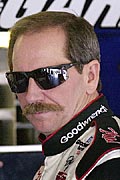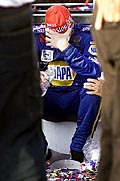By Mike Harris
Associated Press
DAYTONA BEACH, Fla. — The Intimidator. Old Ironhead. Tough and unyielding, a winner on the racetrack and often sarcastic and calculating off of it.
 |
| It is speculated whether safety devices would have saved Dale Earnhardt.
Associated Press |
Even people who knew nothing about racing knew Dale Earnhardt's craggy, mustachioed face and his reputation as a driver never afraid to bang fenders or shake his fist at a rival.
Despite those traits and his rough appearance- or maybe because of them — Earnhardt was a key figure in the explosive growth of NASCAR during the past 20 years from a regional sport into a mainstream America powerhouse.
That's what made his death in Sunday's Daytona 500 so shocking.
"This is incredible, just incredible,'' driver Jeremy Mayfield said. "You figure he'll bounce right back. Your first thought is, 'Hey, he'll probably come back next week at Rockingham and beat us all.'''
As word of the fatal, last-lap wreck spread, fans cried and the big flag in the middle of Daytona International Speedway's vast infield waved forlornly at half-staff.
The death of Earnhardt — still a championship contender at 49 — was the biggest blow to auto racing since the 1994 crash that killed Formula One star Ayrton Senna.
On the day NASCAR began a new era with the return of Dodge after a 16-year absence and the beginning of a six-year, $2.8 billion TV contract, it's biggest draw was suddenly gone.
Earnhardt was the first driver killed in the Daytona 500, which began in 1959. Six drivers have died of injuries from wrecks during practice or qualifying races for the 500.
Neil Bonnett, one of Earnhardt's best friends, was killed in 1994. Rodney Orr died in a wreck three days later, also in practice, and was the last Winston Cup driver killed at the track until Earnhardt's crash.
Earnhardt died perhaps because of an uncharacteristic decision to let his son and the newest driver on his own team fight it out for the victory while he protected their flank.
Earnhardt crashed on the last turn of the last lap vying for third place at the front of a tight five-car pack. In front of him, Michael Waltrip held off Dale Earnhardt Jr. for what should have been the biggest moment in the short history of Dale Earnhardt Inc.
Earnhardt had to be cut from his battered car and was taken to Halifax Medical Center, where he was pronounced dead of head injuries.
Safety personnel tried furiously to save him, three EMS workers leaning into the car, working on Earnhardt, and two firefighters ripping off the roof to get him out.
"He had what I felt were life-ending type injuries at the time of impact and nothing could be done for him,'' said Dr. Steve Bohannon, an emergency physician at the hospital who also works for the speedway.
The crash began when the back left corner of Earnhardt's famed black No. 3 Chevrolet bumped with Sterling Marlin's Dodge.
 |
| Victory was hard to accept for Michael Waltrip, who learned that his friend and team member Dale Earnhardt had been involved in a fatal crash less than a half-mile from the finish line of the Daytona 500.
Associated Press |
Earnhardt's car fishtailed slightly and briefly slid to its left, down toward the infield, before suddenly swinging back to the right and cutting across traffic at a sharp angle. He hit the wall headfirst and Ken Schrader's yellow Pontiac crashed into the passenger side of his car.
With Earnhardt's Chevy already smoking and shredding at the front, Schrader's car stayed lodged into its side, forming a T. The cars careened again off the wall, plowing into the final turn and sliding to a stop.
Both cars ended up in smoking heaps on the infield grass.
"I guess someone got into Dale because Dale got into me and then we went up,'' the uninjured Schrader said. "We hit pretty hard and Dale hit harder.''
The accident removed all the luster from a glittering race that kept the record crowd of 195,000 spectators on their feet most of the afternoon.
Nearly two hours after the race, NASCAR president Mike Helton, his voice breaking with emotion, walked into the infield media center with the unbelievable news.
"This is undoubtedly one of the toughest announcements I have ever personally had to make. We've lost Dale Earnhardt,'' Helton said.
Earnhardt was a seven-time Winston Cup champion, and his 76 victories were the most among active drivers. He continued to race for longtime friend and boss Richard Childress while starting his own team, which expanded to three cars with the addition of Waltrip this year. His other drivers were Earnhardt Jr. and Steve Park.
The elder Earnhardt's death was a particularly devastating blow for NASCAR after a 2000 season in which three of its young stars were killed in separate accidents.
Adam Petty, the fourth generation of stock car racing's most famous family, and Kenny Irwin died in crashes two months apart at New Hampshire International Speedway. Tony Roper was killed later in October in a crash during a truck race at Texas Motor Speedway. All three died of the same type of head injuries that apparently killed Earnhardt.
Since those deaths, safety has become a major issue, with a debate over possible rules changes and the use of new safety equipment.
Earnhardt wore an old-fashioned open-faced helmet and shunned some of NASCAR's other basic safety innovations. He didn't like the restrictor plates NASCAR used to slow speeds at its fastest tracks, where he was a master. He also refused to wear a Head And Neck Safety (HANS) brace that recently has been touted as a way to help prevent serious head injuries.
Bohannon said Earnhardt probably died of head injuries, particularly to the base of the skull.
"I know the full-face helmet wouldn't have made a difference,'' Bohannon said. "I don't know if the HANS device would have helped. I suspect not.''
The crash, however, didn't look that serious at first. Most of the fans' attention at the time was on the fight for the checkered flag between Waltrip and Earnhardt Jr.
With two- and three-wide racing and constantly changing positions, there was a far more dangerous-looking wreck 26 laps earlier. The 19-car accident sent Tony Stewart's Pontiac flying through the air and over the roof of another car. Stewart also was taken to the hospital, where he was treated for a concussion.
Earnhardt's death completely overshadowed the victory by Waltrip, his first in 15 years and 463 races on Winston Cup circuit.
At first, Waltrip, the younger brother of retired three-time champion Darrell Waltrip, was jubilant, scrambling from his car in Victory Lane and shouting in a raspy voice: "This is the Daytona 500, and I won it! I won the Daytona 500! I can't believe it!''
But he was somber as it became apparent that his new boss, who gave him a chance to race with the best equipment of his career, was badly injured.
"The only reason I won this race is Dale Earnhardt,'' Waltrip said.
Waltrip took the lead 16 laps from the end of the 200-lap race and stayed in front.
Thanks to the aerodynamic package that NASCAR came up with to promote better racing after last year's yawner at Daytona, the 43rd version of the stock car Super Bowl produced 49 lead changes among 14 drivers. Last year, there were just nine lead changes and virtually no real racing.
The excitement was back this year — so was the danger. And now the sport has been left without one of its greats.
[back to top] |


